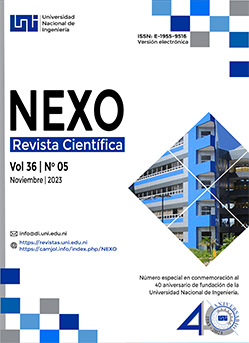Aqua balls effect on solar still productivity using water blended
DOI:
https://doi.org/10.5377/nexo.v36i05.17280Keywords:
Solar still, porosity, wastewater, photovoltaic, productivityAbstract
With the use of filter ball, the performance regarding the rowing motor solar still is examined. The belt is rotated by a DC motor (6W) that is powered through a small photovoltaic (PV) system. Also, research is done on how employing porous media affects the rowing filter still's performance. The best rowing filter performance, without or with porous media, was found to be achieved at the 30-minute OFF time, according to the results. Additionally, the rowing filter ball in solar still produced 183% more in total compared to standard distiller did. Tow rowing shafts in solar still: New mechanism of desalination Absorbent materials in the stills increase water absorption, and absorb heat when exposed to solar radiation. These materials serve as heat storage media and increase the wetted surface area. The water yield for CSS is improved by 188% when the AQUA balls balls are agitated within the water in the still basin.
Downloads
818
Downloads
Published
How to Cite
Issue
Section
License
Copyright (c) 2023 Universidad Nacional de Ingeniería

This work is licensed under a Creative Commons Attribution 4.0 International License.
The authors who publish in Nexo Scientific Journal agree to the following terms:
- Authors retain the copyright and grant the journal the right of the first publication under the license Creative Commons Attribution License, which allows others to share the work with a recognition of the authorship of the work and the initial publication in Nexo Scientific Journal.
- Authors may separately establish additional agreements for the non-exclusive distribution of the version of the work published in the journal (for example, in an institutional repository or a book), with the recognition of the initial publication in Nexo Scientific Journal.
- Authors are allowed and encouraged to disseminate their works electronically (for example, in institutional repositories or in their own website) before and during the submission process, as it can lead to productive exchanges, as well as earlier and greater citation of published works.










